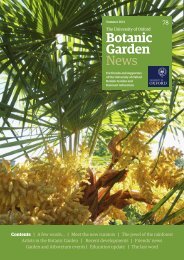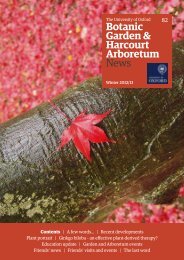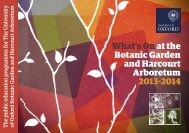6 <strong>Botanic</strong> <strong>Garden</strong> <strong>News</strong> | No. 77Recent developments at the<strong>University</strong> <strong>of</strong> <strong>Oxford</strong> <strong>Botanic</strong> <strong>Garden</strong>and <strong>Harcourt</strong> <strong>Arboretum</strong>byTimothyWalker<strong>The</strong> <strong>Botanic</strong> <strong>Garden</strong>Hardy Collection<strong>The</strong> first frost came in the middle <strong>of</strong> October2010 and the dahlias were no more. <strong>The</strong>autumn was earlier than in the past fewyears, and short but quite spectacular;by the middle <strong>of</strong> November the <strong>Garden</strong>was looking very sad and ready to be putto bed. On the morning <strong>of</strong> Friday 17thDecember the sky over St Hilda’s Collegewas an ominous bright red, reminiscent <strong>of</strong>January 4th nearly 12 months earlier. It wasobserved that 36 hours after that Januarysunrise we were knee-deep in snow andsure enough by lunch time on December18th, 20cm <strong>of</strong> the wretched white stuff wascovering the <strong>Botanic</strong> <strong>Garden</strong>.In the subsequent week the airtemperature fell to –140C and the snowremained. <strong>The</strong> evergreen plants stickingup above it started to suffer. Cistus andcoronillas were looking miserable, exceptfor their lower 200mm. I assumed that<strong>The</strong> <strong>Garden</strong> under heavy snow,December 2010those plants covered in the ‘blanket’ werefine and this hypothesis was tested when itcame to harvesting vegetables from our ownplot for Christmas dinner. It was discoveredthat, sure enough, the soil was not frozenand the carrots and parsnips were easilypulled, in contrast to the year before whenan axe was required.<strong>The</strong> list <strong>of</strong> plants flowering on January1st was shorter than usual even thoughthe snow had melted. <strong>The</strong> Hamamelismollis, which is normally a sure bet to beflowering on Christmas day, did not reallystart its display <strong>of</strong> colour and scent untilthe middle <strong>of</strong> January. Despite the advicein many gardening books, you can growHamamelis on alkaline soils. <strong>The</strong> criticalfeature for successful cultivation appearsto be a moisture-retentive soil in the plant’sformative years before it has grown rootsdown to the water table. <strong>The</strong> Chimonanthuspraecox was also flowering well by themiddle <strong>of</strong> January along with Viburnum xbodnantense ‘Dawn’, Jasminum nudiflorum‘Seiboldianum’, and Lonicera x purpusii.In a strong cast <strong>of</strong> smelly plants thewinner must be Sarcococca confusa. This isa Top 10 plant if ever there was. <strong>The</strong> scentengulfs you like a blanket and is completelyout <strong>of</strong> proportion with the size <strong>of</strong> theflowers. Only the male flowers producenectar but it is not clear whether both sexesproduce scent. <strong>The</strong> other incongruousfeature <strong>of</strong> this species is the simultaneousflowering and fruiting; the black berries arein fabulous contrast to the white flowers.<strong>The</strong>re must be a reason why the plant delaysChimonanthus praecoxthe development <strong>of</strong> its fruit for twelvemonths; possibly because the release <strong>of</strong>seeds in the summer would coincide withdry conditions in its native China.<strong>The</strong>re were eleven species <strong>of</strong>Sarcococca at the last count (in 1986)growing from Afghanistan to Chinaand into the Philippines. <strong>The</strong>ir leavesall resemble those <strong>of</strong> Ruscus aculeatus(Butchers’ broom), especially the leaves<strong>of</strong> Sarcococca ruscifolia, though the leaves<strong>of</strong> the Ruscus are not leaves – they arephylloclades (from the Greek phyllo =leaves and klados = branch). So when isa leaf not a leaf? When there are flowersgrowing from it. In Ruscus the flowersappear to be growing from the centre<strong>of</strong> the leaves, which means that theleaves are in fact stems or branches thatresemble leaves. <strong>The</strong> leaves are presentbut in Ruscus aculeatus they are thesmall brown structures at the base <strong>of</strong> theflowers. <strong>The</strong> leaves <strong>of</strong> Ruscus hypoglossumare much more clearly visible.Hamamelis mollisRuscus aculeatusLeaves come in many different shapesand sizes and with many more functionsthan just photosynthesis. A new secondyearundergraduate practical class tookplace in the <strong>Garden</strong> in late October in whichthe students had to inspect sixty differentspecies and to comment on the leaves,their morphology and function. <strong>The</strong> result<strong>of</strong> this work is that the students now knowthat a leaf is a structure at the base <strong>of</strong> a bud(subtending the bud to be precise) and thefunction is immaterial.
<strong>Botanic</strong> <strong>Garden</strong> <strong>News</strong> | No. 777<strong>The</strong> <strong>Botanic</strong> <strong>Garden</strong>GlasshousesA great advantage that botanic gardens<strong>of</strong>ten have over other gardens is that theyhave glasshouses. Before Jacob Bobartretired in 1679 (he also died in this year) wehad a single ‘conservatory for evergreens’to grow the plants through the winter.Now we have a range <strong>of</strong> Glasshouses fromcompletely unheated to rather warm –minimum <strong>of</strong> 160C. During the cold spell thiswinter the boilers managed to give us the300C lift that they were designed to deliver.During these months (and coincidingwith teaching, as if it were planned) theGlasshouses are home to a good number <strong>of</strong>flowering plants and in particular monocotsand especially members <strong>of</strong> the familiesAraceae, Orchidaceae, Bromeliaceae,Asphodelaceae and Musaceae sensu lato.<strong>The</strong> <strong>Garden</strong>’s collection <strong>of</strong> bromeliads(members <strong>of</strong> the family Bromeliaceae) hasimproved during the past few years. This isan interesting, medium-sized family with2,650 species in 59 genera. Its distributionis almost exclusively tropical Americanexcept for one species which is found intropical West Africa, Pitcairnia feliciana.(<strong>The</strong> same distribution pattern is found inthe Cactaceae with just Rhipsalis bacciferagrowing outside the New World.) While theBromeliaceae is a well-defined family, thegroups within the family are much harderto see and building the evolutionary tree forthem is difficult.Many species are epiphytic, growing onthe bark and branches <strong>of</strong> trees. It is believedthat these epiphytes were pre-adapted tothis dry habitat by a number <strong>of</strong> xeromorphicadaptations. <strong>The</strong>y <strong>of</strong>ten have a very toughleaf cuticle, with spines on the margin. <strong>The</strong>yalso <strong>of</strong>ten have a modification <strong>of</strong> standardphotosynthesis known as Crassulacean acidmetabolism (CAM), first identified in plantssuch as Crassula ovata. CAM enables the<strong>The</strong> Bromeliad Aechmea pinelianaCrassula ovataplant to fix carbon dioxide in the dark. Thissaves water because in order to fix CO 2 thestomata must be open to allow the ingress<strong>of</strong> the air. Unfortunately, permitting theingress <strong>of</strong> air also allows the egress <strong>of</strong> water.So if the stomata are open only duringthe cooler night-time then the plant willconserve precious water.Many members <strong>of</strong> the Bromeliaceaehave water tanks at the bases <strong>of</strong> their leaves,and these are such a permanent part <strong>of</strong>the ecosystem that other species, rangingfrom frogs to algae, have evolved to exploitthem as a habitat. It appears that thesetanks have more to do with nutrition thanwith the capture, storage and supply <strong>of</strong>water. In some species the volume <strong>of</strong> water<strong>The</strong> <strong>Harcourt</strong><strong>Arboretum</strong>Autumn arrived quickly at the end <strong>of</strong>October and then made a run for it so thewhole season seemed to last just a fortnight.Since then the <strong>Arboretum</strong> has been grey andincreasingly wet.<strong>The</strong> Rycote sheep have been happilygrazing Pylon Meadow and Palmer’s Leys.<strong>The</strong> final third <strong>of</strong> the meadow in the latterwas successfully sowed in September 2010and when the snow melted there was a greenlayer <strong>of</strong> seedlings covering the soil. It appearsthat the germination from an autumn sowingis much more botanically uniform than froma spring sowing. <strong>The</strong> middle third <strong>of</strong> themeadow was sown in spring 2010 becausethe soil was too wet for sowing the previousautumn; there is an almost complete absence<strong>of</strong> grasses but there are a large number <strong>of</strong>Epilobium seedlings that have not beenfound elsewhere in Palmer’s Leys.<strong>The</strong> autumn work at the <strong>Arboretum</strong>is quite different from that at the <strong>Garden</strong>.One <strong>of</strong> the most creative activities is hedgelaying.On November 20th John Savings rana one-day hedge-laying course. <strong>The</strong>re arenumerous different styles <strong>of</strong> hedge-laying,many centred on particular counties andregions. John is an inspiring tutor and hispupils made a beautiful job <strong>of</strong> the mixednative species hedge on the north boundary<strong>of</strong> Pylon Meadow.stored in one plant can be as much as 20litres and at least one, Catopsis berteroana,secretes enzymes into the water to digestdead organic matter. Economically theBromeliads are important as tropicalbedding (6,000 cultivated varieties,especially Guzmania) and upholsterystuffing (the bizarre air plant Tillandsiausneoides, Spanish moss, found throughoutthe Glasshouses) but most importantly asthe supplier <strong>of</strong> pineapples.<strong>The</strong> bromeliads are spread throughoutthe Glasshouses with only one, Fasciculariapitcairnifolia, hardy in <strong>Oxford</strong>. In the sameway there is one species <strong>of</strong> Aloe that ishardy, Aloe striatula, while the rest needsome protection. <strong>The</strong>re are 446 species <strong>of</strong>Aloe and many thrive and flower well inthe Arid House including the famous Aloevera. This is a ‘herbal remedy’ that is onthe cusp <strong>of</strong> being accepted by the clinicalcommunity. In Africa many species <strong>of</strong> Aloeare used for their healing properties. <strong>The</strong>yare mentioned in Babylonian texts so theyhave been used in the Mediterranean regionfor several millennia. Extract <strong>of</strong> Aloe veracontains the antibiotic barbaloin which inthe juice <strong>of</strong> Aloe vera penetrates the skinfour times faster and seven times deeperthan in water. <strong>The</strong> juice also contains all theessential amino acids and twelve vitamins.Hedge-laying at the arboretumWinter is the traditional time for treesurgery and part <strong>of</strong> the work for this winteris the removal <strong>of</strong> five sycamores on theedge <strong>of</strong> the Acer Glade. <strong>The</strong>se trees aredangerous and if they fell would land acrossthe all-weather path running along thecentre <strong>of</strong> the glade. In addition to removingdangerous trees and making others safe thereis tree planting. <strong>The</strong> oaks are still failing toregenerate naturally in Bluebell Wood and soit has been decided that fifty new oaks alongwith fifty birch trees to act as nurses will beplanted in the centre <strong>of</strong> the wood. <strong>The</strong>se willhave to be well protected from the wretcheddeer but also must be visible to the personflailing bracken in the winter. This meansthat visitors will be able to see the cages fromthe path during the bluebell flowering periodbut this is a small price to pay for a few yearswhile the trees become big enough to lookafter themselves.






